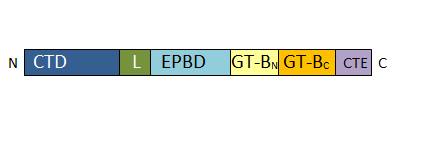Sandbox Reserved 1136
From Proteopedia
(Difference between revisions)
| Line 42: | Line 42: | ||
[[Image:Monomer structure.jpg]] | [[Image:Monomer structure.jpg]] | ||
''Primary structure of Atsus1 monomer. CTD : for Cellular Targeting Domain (residues 0-127); L for Linker (residues 128-156); EPBD: for ENOD40 Peptide-Binding Domain (residues 157-276); GT-B glycosyltransferase : Gt-BN (residues 277-526) and Gt-BC (residues 527-754); CTE for C-Terminal Extension (residues 776-808)'' | ''Primary structure of Atsus1 monomer. CTD : for Cellular Targeting Domain (residues 0-127); L for Linker (residues 128-156); EPBD: for ENOD40 Peptide-Binding Domain (residues 157-276); GT-B glycosyltransferase : Gt-BN (residues 277-526) and Gt-BC (residues 527-754); CTE for C-Terminal Extension (residues 776-808)'' | ||
| + | |||
The SUS1 tetramer is flat, with two types of hydrophobic subunit interfaces, the A:B and A:D interfaces. The A:D interface is an interaction between the C-terminal extension and the linker, whereas the A:B interface is created by the interaction of adjacent EPBD domains. | The SUS1 tetramer is flat, with two types of hydrophobic subunit interfaces, the A:B and A:D interfaces. The A:D interface is an interaction between the C-terminal extension and the linker, whereas the A:B interface is created by the interaction of adjacent EPBD domains. | ||
| Line 59: | Line 60: | ||
• The CTD can possibly move as a rigid body and interact with F-actin, where the groove and EPBD can be in contact with actin fiber. It may create a pathway for actin binding, and modulation of the Sucrose Synthase activity. | • The CTD can possibly move as a rigid body and interact with F-actin, where the groove and EPBD can be in contact with actin fiber. It may create a pathway for actin binding, and modulation of the Sucrose Synthase activity. | ||
| - | |||
• In other organisms, it has been shown that the Sucrose Synthase is active into its dimer form, it is supposed to be the same phenomenon in ''Arabidopsis thaliana'', though it has not been prouved. | • In other organisms, it has been shown that the Sucrose Synthase is active into its dimer form, it is supposed to be the same phenomenon in ''Arabidopsis thaliana'', though it has not been prouved. | ||
Current revision
| This Sandbox is Reserved from 15/12/2015, through 15/06/2016 for use in the course "Structural Biology" taught by Bruno Kieffer at the University of Strasbourg, ESBS. This reservation includes Sandbox Reserved 1120 through Sandbox Reserved 1159. |
To get started:
More help: Help:Editing |
Structure and Functional aspects of Sucrose Synthase 1 from Arabidopsis thaliana
Sucrose Synthase 1 (EC:2.4.1.13), also known as the sucrose-UDP glucolsyltransferase 1, is a reversible enzyme allowing the synthesis or the degradation of sucrose in Arabidopsis thaliana. It is a 360 kDa tetramer and belongs to the Glycosyltransferase subfamily 4 (GT4).
| |||||||||||
References
• 3D structure and informations mainly extracted from: The Structure of Sucrose Synthase-1 from Arabidopsis thaliana and Its Functional Implications. Zheng, Y., Anderson, S., Zhang, Y., Garavito, R.M. (2011) J.Biol.Chem. 286: 36108-36118.
• UniProt entry: P49040
• Brenda entry : 2.4.1.13
- ↑ Salerno GL, Curatti L Origin of sucrose metabolism in higher plants: when, how and why? Trends Plant Sci. 2003 Feb
- ↑ Baroja-Fernández, E., Muñoz, F.J., Saikusa, T., Rodríguez-López, M., Akazawa, T. and Pozueta-Romero, J. Sucrose synthase catalyzes the de novo production of ADP-glucose linked to starch biosynthesis in heterotrophic tissues of plants. Plant Cell Physiol.
- ↑ 11 Juan Gabriel Angeles N_U ~Nez. Study of sucrose synthase in arabdopsis seed : lacalization, regulation and function. Sciences of the U.
- ↑ Sucrose synthase oligomerization and F-actin association are regulated by sucrose concentration and phosphorylation. Duncan KA, Huber SC. Plant Cell Physiol. 2007 Nov; 48(11):1612-23.
- ↑ Salerno GL, Curatti L. Origin of sucrose metabolism in higher plants: when, how and why? Trends Plant Sci. 2003 Feb
- ↑ Determination of structural requirements and probable regulatory effectors for membrane association of maize Sucrose Synthase 1. Hardin SC, Duncan KA, Huber SC. Plant Physiol. 2006
- ↑ Phosphorylation of Sucrose Synthase at serine 170: occurrence and possible role as a signal for proteolysis. Hardin SC, Tang GQ, Scholz A, Holtgraewe D, Winter H, Huber SC. Plant J. 2003
- ↑ Glycosyltransferases: structures, functions, and mechanisms. Lairson LL, Henrissat B, Davies GJ, Withers SG. Annu Rev Biochem. 2008


